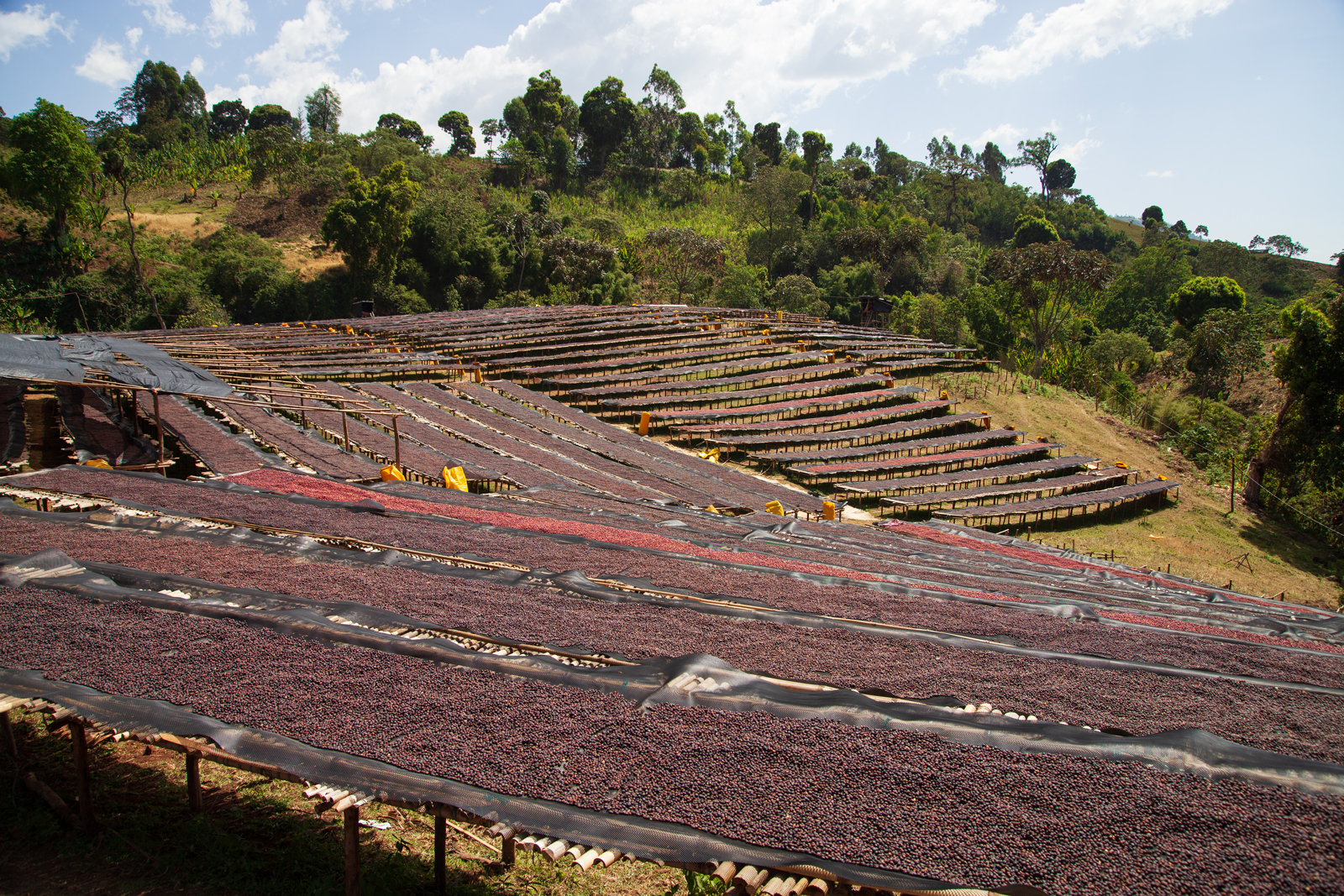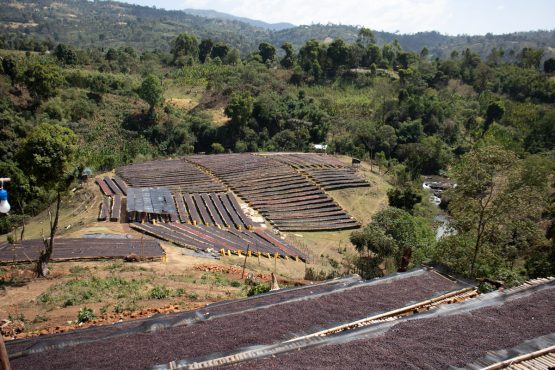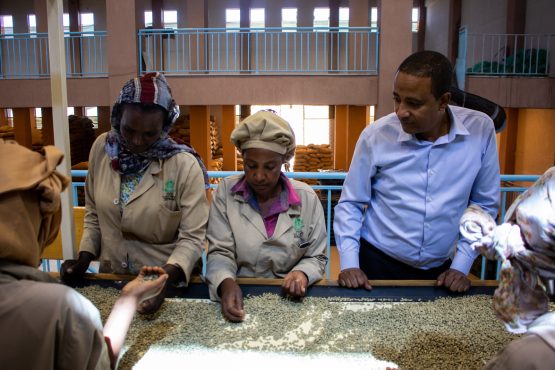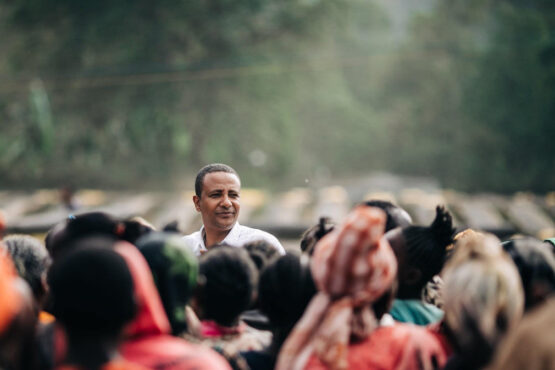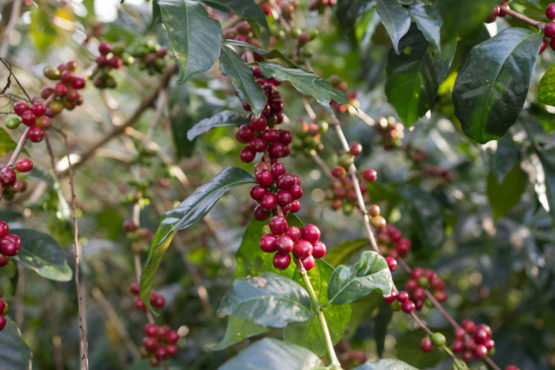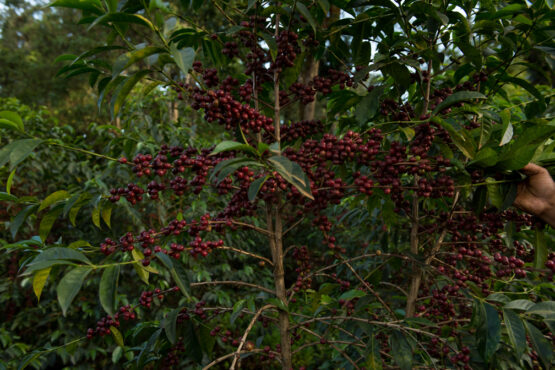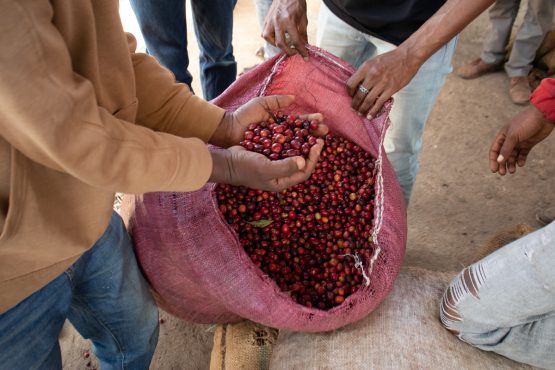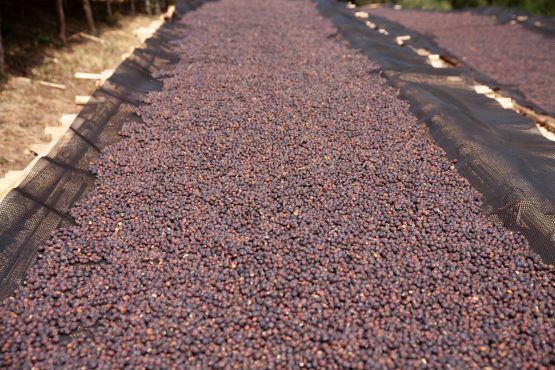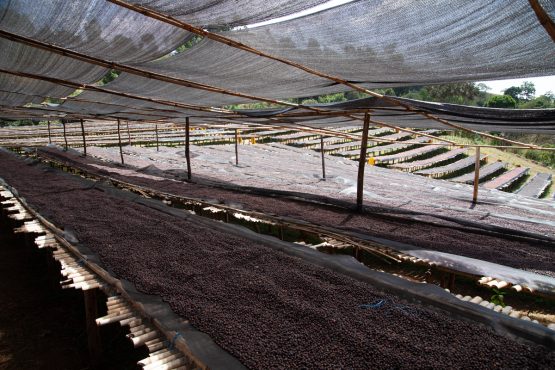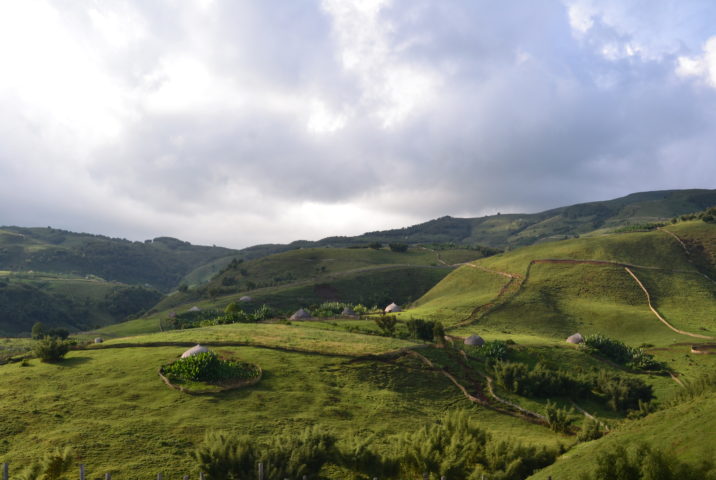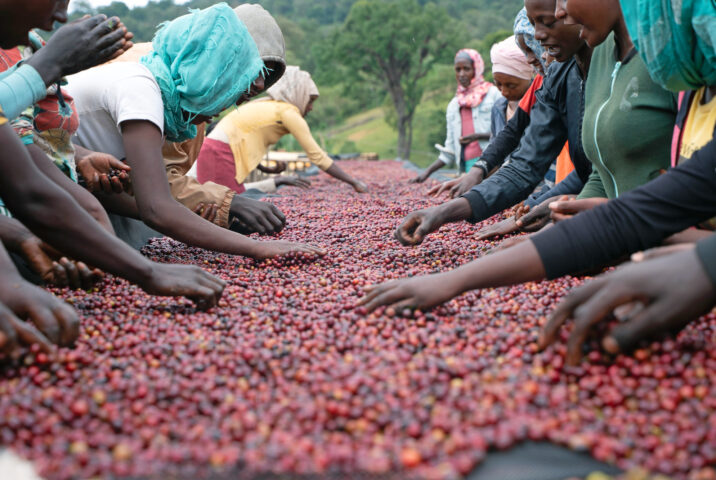Faysel Abdosh Karamo — Taste of Harvest No 2
Complex and floral, with winey acidity and intense sweetness. Kumquat, strawberry and Turkish Delight.
This award-winning microlot was grown in the kebele (local village) of Karamo and processed at Gara Agena, a privately-owned washing station that is located in the Bura woreda (administrative district) in Ethiopia’s Sidama zone. The washing station is one of 26 owned and managed by Testi Coffee, a family-owned company founded by Mr Faysel A. Yonis (for whom this lot is named).
With a whopping score of 89.25, this coffee placed second in the Natural category at the 2024 African Fine Coffees Association (AFCA)’s Taste of Harvest Competition, an annual competition that seeks out for the continent’s most exquisite coffees. The event receives samples from quality-focused coffee producers, cooperatives, millers, and exporters around Africa, which are evaluated by a panel of experienced local and international judges using methods and protocols established by the Coffee Quality Institute (CQI) and Specialty Coffee Association (SCA). For the 2024 event, AFCA evaluated a total of 71 samples from nine countries. We are thrilled to offer this winning lot, which we purchased directly from Testi and air-freighted to Melbourne.
ABOUT GARA AGENA WASHING STATION
Gara Agena produces exceptional natural and special preparation lots. The washing station was built by Testi in 2020 as one of their ‘Premium’ facilities, which are selected for their natural advantages – including it’s high elevation, the surrounding region’s characteristics and access to fresh, clean water. By choosing sites in areas favoured with great growing conditions and paying premiums for properly harvested fruit, Testi ensures they only receive extremely high quality cherry, resulting in outstanding complexity and distinction in the resulting cup.
Sitting at a staggering 2,250m above sea level, Gara Agena was built on the slopes surrounding the Geta River, which runs in a U-shape around the site. The fresh, running water creates a cool micro-climate around the coffee as it dries on raised African beds, slowing down the drying process and contributing to the cup profile.
At Gara Agena, Testi separates and processes each kebele’s cherry delivery as a distinct lot, providing extra traceability. This particular coffee comes from the kebele of Karamo.
During harvest, freshly picked coffee cherry is delivered daily by between 400 – 500 independent outgrowers from the small kebele of Karamo. The harvest in Karamo is later than most other nearby villages and coffee cherries grown here are quite small, both due to the kebele’s high elevation and cool climate. Testi has strict standards in place for the quality of cherry delivered to Gara Agena, only accepting ripe, red fruit that will produce the sweetest and most complex lots. This meticulous and selective approach, along with the relatively small number of contributing outgrowers, adds to the distinct cup quality of this coffee.
The majority of the families that contribute to this lot farm organically on tiny plots of land, which average less than one hectare in size. Coffee is their main cash crop and grows alongside food crops of corn, grain and bananas, under the shade of native Birbira, Wanza, and Acacia trees. The average elevation of the farms in this region is very high – around 1,995–2,230m above sea level – and this, combined region’s cool temperatures, is ideal for the slow ripening of coffee cherries, leading to denser beans and a sweeter, more complex cup profile.
ABOUT THE SIDAMA COFFEE REGION
Historically, the Sidama coffee region refers to a wide geographical area encompassing much of central-south Ethiopia, that is well known for producing exceptional natural and washed coffees. The region is located in Ethiopia’s South East Coffee Zone, and includes renowned coffee-producing localities such as Yirgacheffe, Kochere, West Arsi, Bensa and Guji. After a 2019 Referendum, some of the territories within the Sidama coffee region formed an autonomous regional state. This coffee region now extends across the states of Sidama, Oromia and the Southern Nations, Nationalities, and People’s Region (SNNPR), three of eleven ethnically-based regional states of Ethiopia.
Coffees that are grown and processed in Sidama showcase an extremely diverse range of flavour profiles, and are noted for their intensely fruit-forward, tea-like, floral and complex character that is sought after worldwide. It is widely accepted that the coffee species, Arabica, originated in the lush forests of southern forests of Ethiopia and hence growing conditions in this area are perfectly suited for producing exquisite coffees.
The Sidama coffee region is named for the Sidama people, a tribe with a long and proud history of coffee production. Coffee has been here for centuries and is an important source of income for rural households, who grow it as the primary cash crop. Family plots are small and intensively farmed with intercropped coffee, food crops like pulses, grain and yams, and other cash crops like khat (similar to tobacco) and Ethiopian banana. Most farms are planted amongst or alongside indigenous forest trees, which provide a thick canopy of shade for the coffee trees. Historically, farmers in this area will use organic farming practices (although it is unlikely to be certified) as there is no ready access to artificial fertilisers or pesticides.
VARIETY
This coffee is mostly made up of the two dominant JARC varieties in the region: 74110 & 74158.
For many years, most Ethiopian coffees have been described as being a mix of cultivated and wild varieties, referred to as “heirloom varieties.” This is a term that is all-encompassing and used by many actors in the coffee industry to generally categorise Ethiopian coffee varieties that are from native forest origins. Whilst “heirloom” describes many of the varieties found in Ethiopia, it is also a bit simplistic and does not acknowledge the varieties that are already locally recognised and purposely cultivated, or those that have been specifically developed and widely distributed by the Jimma Agricultural Research Centre (JARC).
Sidama is home to many landrace varieties that were originally selected from the forest and have been propagated successfully for decades. There are five popular varieties that are named after indigenous trees in the area— Bedessa, Kurume, Mique, Sawe and Wolisho. There is little documentation on the history of these varieties, and it is hard to know if they represent a single plant or a wider group of varieties; however, it is widely accepted that they play a major role in the quality and floral flavour profile of the coffee from this region. JARC varieties were developed using “mother trees” from Ethiopia’s coffee forests, and are now grown for disease and pest resistance, as well as exceptional cup profile, and are released by number. For example, 74110, 74112 and 74116 are all widely propagated in the Sidama growing region.
PROCESSING
This coffee was processed using the natural method; a complex process requiring a high level of attention to detail in order to be done well. Ethiopian coffee has been processed this way by generations of farmers who have mastered the art of the natural method through centuries of tradition and experience. This coffee is classified as Grade 1, indicating that a lot of effort has been put into the selection, grading and drying to ensure the very highest quality coffee is produced.
Each day, carefully hand-picked coffee cherries were delivered to Gara Agena washing station and were meticulously sorted by hand to remove unripe or damaged fruit. Some 85% of the cherries selected were perfectly ripe, 10% were over ripe and 5% were slightly under-ripe.. These are then water sorted to remove all “floaters,” which are lower in density and considered to be of inferior quality, as this enhances the quality and sweetness of the cup.
The coffee was then partitioned into 25kg bunches and laid to dry on raised beds. Coffee cherries are placed in very thin layers, on raised beds that receive less sunlight and more wind, to slow down the drying. Cherries are also turned by staff five to six times a day to to ensure consistent drying and prevent over-fermentation. This is done very carefully to avoid damage to the fruit. At midday, the coffee is covered to protect it from full sun. It is also covered overnight to prevent damage from morning dew.
Once the coffee reached the optimum moisture level (for this lot, it was around 35 days), it was hulled and rested in bags in parchment until it is ready for export.
HOW THIS COFFEE WAS SOURCED
Since 2018, regulation changes within the Ethiopian coffee industry have allowed smallholder producers and coffee washing stations to export coffee directly to the international market, rather than through the Ethiopian Commodity Exchange (ECX), a model called Vertical Integration. While the ECX has provided stability and opportunity for many Ethiopian coffee farmers, it does not service the specialty market well, as there is an inherent lack of transparency and traceability in its auction model, and more points for potential corruption or confusion between the producing communities and the final buyer.
Vertical Integration enables a more streamlined coffee supply chain and provides an opportunity for the increased traceability and transparency of coffee trade in Ethiopia. Beyond this, producers who market and trade their coffee directly can access higher prices and more direct payments for their coffees. All of the coffee we purchase in Ethiopia is bought outside of the ECX system.
This coffee was sourced through our on-the-ground Ethiopian supply partner, Sucafina Ethiopia, who help connect us to single estates, privately owned washing stations and quality-focused exporters in different regions of Ethiopia. Based in Addis Ababa, Sucafina Ethiopia work as a service provider connecting local farmers and exporters (colloquially known as ‘shippers’) with international buyers like MCM. By Ethiopian law, they (and other foreign-owned entities) are not permitted to buy cherries directly, or to own washing stations or mills; however, their expertise is invaluable in coordinating multiple shippers, ensuring quality standards are met and handling all logistics in the preparation and local transport of our coffees. Through our shared commitment to responsible sourcing practices, quality and traceability, we have been connected to likeminded shippers, like Testi, who work to produce delicious and consistent coffees while running social programs that directly and meaningfully support coffee farmers and their families.
WHY WE LOVE IT
The word “testi” means happiness in the Harrari language, which is fitting as their coffees make us very happy! This lot is a fine example of the distinctive and unique nature of coffee produced in the region, and Testi’s meticulous approach to experimental fermentation. We love this natural lot for its bright, complex acidity, floral complexity and intense sweetness.
